Hunger around the world
SUMMARY
Hunger is a worldwide problem. More than 700 million people around the world experience hunger every day. In 45 countries, more than 50 million people are facing emergency levels of hunger – meaning they are struggling to live in the face of famine.
2 MIN READ
Asia
In recent decades, as its economies have grown, poverty has declined and food production has increased. The number of hungry people in Asia has also declined, but Asia still has two-thirds of the world’s hungry people.
In South Asia, there has been very slow progress against hunger. More than 40 percent of children in India are stunted (too short for their age group) due to malnutrition, according to the Population Reference Bureau. The global food price and economic crises of 2007-2008 caused a spike in hunger in the region.
Sub-Saharan Africa
Just over a quarter of the world’s people who experience hunger live in the countries south of the Sahara Desert in Africa. Progress against hunger has been slow in this region. In 1990, 1 in 3 people in the region were undernourished. Today, 1 in 4 suffer from hunger. Conflicts, climate change, and economic inequality have slowed progress.
Most people experiencing hunger and poverty in sub-Saharan Africa still live in rural areas and depend on the land for their livelihoods. Decades of underinvestment in agriculture hampered their productivity. More frequent droughts and other weather shocks also hurt farmers’ ability to produce enough food.
North Africa And The Middle East
The 2007-2008 food price crisis, political instability, and years of war have led to an increase in hunger in the region. Afghanistan, Syria, and Iraq are called “fragile states” because long-term war and conflict have devastated systems and communities.
In Syria alone, civil war has destroyed nearly every farm. This has led to a near-total reliance on international food aid from donor countries like the U.S. Four million people there are being given food assistance each month — more than the population of Los Angeles.
Latin America And The Caribbean
A devastating earthquake in 2010 affected one-third of Haiti’s entire population and required large amounts of food aid and other assistance. Haiti’s economy and its ability to produce food have not fully recovered, not least due to continuing natural disasters and political instability.
In Central America, specifically in Honduras, Guatemala, and El Salvador, hunger in these countries has been building steadily over the past several years, driven by climate change, extreme poverty, and violence. Chronic malnutrition rates in Indigenous communities in the Americas are among the highest in the world.

Asia
In recent decades, as its economies have grown, poverty has declined and food production has increased. The number of hungry people in Asia has also declined, but Asia still has two-thirds of the world’s hungry people.
In South Asia, there has been very slow progress against hunger. More than 40 percent of children in India are stunted (too short for their age group) due to malnutrition, according to the Population Reference Bureau. The global food price and economic crises of 2007-2008 caused a spike in hunger in the region.

SUB-SAHARAN AFRICA
Just over a quarter of the world’s people who experience hunger live in the countries south of the Sahara Desert in Africa. Progress against hunger has been slow in this region. In 1990, 1 in 3 people in the region were undernourished. Today, 1 in 4 suffer from hunger. Conflicts, climate change, and economic inequality have slowed progress.
Most people experiencing hunger and poverty in sub-Saharan Africa still live in rural areas and depend on the land for their livelihoods. Decades of underinvestment in agriculture hampered their productivity. More frequent droughts and other weather shocks also hurt farmers’ ability to produce enough food.

NORTH AFRICA AND THE MIDDLE EAST
The 2007-2008 food price crisis, political instability, and years of war have led to an increase in hunger in the region. Afghanistan, Syria, and Iraq are called “fragile states” because long-term war and conflict have devastated systems and communities.
In Syria alone, civil war has destroyed nearly every farm. This has led to a near-total reliance on international food aid from donor countries like the U.S. Four million people there are being given food assistance each month — more than the population of Los Angeles.

LATIN AMERICA AND THE CARIBBEAN
A devastating earthquake in 2010 affected one-third of Haiti’s entire population and required large amounts of food aid and other assistance. Haiti’s economy and its ability to produce food have not fully recovered, not least due to continuing natural disasters and political instability.
In Central America, specifically in Honduras, Guatemala, and El Salvador, hunger in these countries has been building steadily over the past several years, driven by climate change, extreme poverty, and violence. Chronic malnutrition rates in Indigenous communities in the Americas are among the highest in the world.
